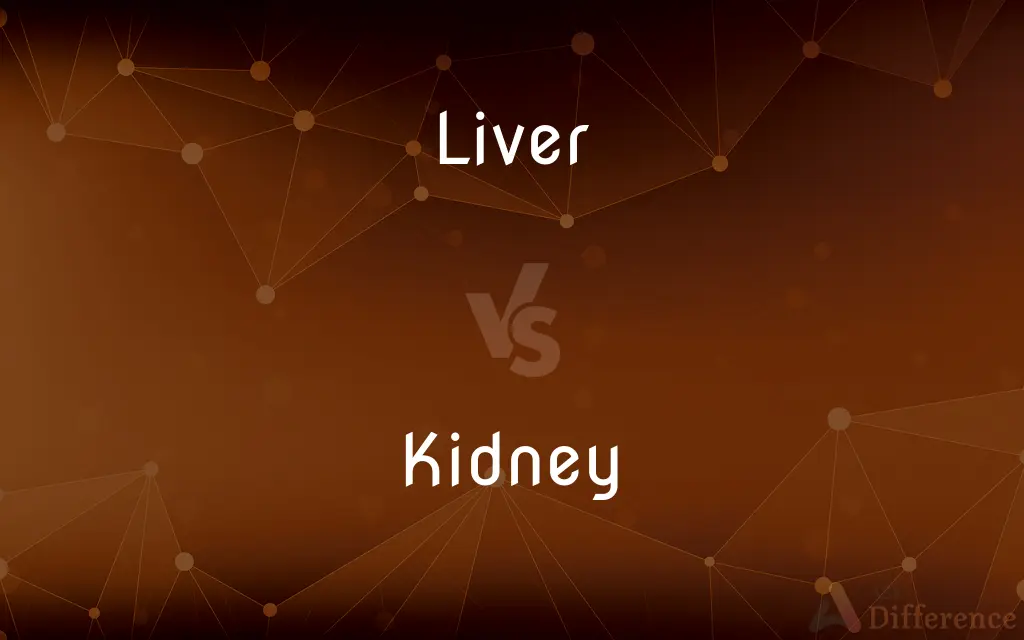Liver vs. Kidney — What's the Difference?
Edited by Tayyaba Rehman — By Fiza Rafique — Updated on September 25, 2023
The liver is an organ that metabolizes nutrients, detoxifies harmful substances, and produces bile. The kidney filters blood to remove waste and regulate electrolytes. Both are vital but perform distinct functions in digestion and waste management.

Difference Between Liver and Kidney
Table of Contents
ADVERTISEMENT
Key Differences
The liver is a large organ that plays a crucial role in metabolism, digestion, and detoxification of the body. It processes nutrients, produces bile for fat digestion, and detoxifies harmful substances such as alcohol and drugs. On the other hand, the kidney's primary role is in filtration and waste removal. It filters the blood to eliminate waste products and excess substances, including water and electrolytes.
Liver cells, known as hepatocytes, are responsible for producing enzymes that facilitate a wide range of chemical reactions. These cells also store glycogen for energy and create proteins that are essential for blood clotting. In contrast, the kidney contains specialized units called nephrons, which are the basic functional units responsible for filtering the blood and creating urine. Nephrons adjust the levels of water, electrolytes, and waste products.
The liver is unique in its ability to regenerate. Even if up to 75% of liver tissue is removed or damaged, the organ can regenerate to nearly its original size and functionality. The kidney, however, does not have this capability. If a kidney is damaged, it cannot regenerate, but its remaining functional units may adapt to handle the workload.
In terms of location, the liver is situated on the upper right side of the abdominal cavity, just beneath the diaphragm. The kidneys are located at the back of the abdominal cavity, one on each side of the spine. Both the liver and the kidney are essential organs, but they serve different purposes and functions within the digestive and excretory systems.
Comparison Chart
Primary Function
Metabolism and detoxification
Filtration and waste removal
ADVERTISEMENT
Cell Type
Hepatocytes
Nephrons
Regeneration
Can regenerate
Cannot regenerate
Location
Upper right abdomen
Back of abdomen, near spine
Additional Roles
Produces bile
Regulates electrolytes
Compare with Definitions
Liver
The liver is an organ responsible for metabolism.
The liver converts food into energy.
Kidney
The kidney is an organ that filters blood.
The kidneys remove waste from the bloodstream.
Liver
It plays a role in blood clotting.
The liver produces proteins crucial for blood coagulation
Kidney
The kidney cannot regenerate.
If a kidney is damaged, it cannot grow back.
Liver
The liver has the ability to regenerate.
After partial removal, the liver can regrow to its original size.
Kidney
The kidney helps regulate blood pressure.
The kidneys release hormones that control blood pressure.
Liver
It detoxifies harmful substances from the body.
The liver filters out toxins from alcohol.
Kidney
It produces urine to eliminate waste.
The kidneys create urine to expel toxins.
Liver
The liver produces bile for fat digestion.
The liver's bile helps break down fats in the diet.
Kidney
The kidneys are two reddish-brown bean-shaped organs found in vertebrates. They are located on the left and right in the retroperitoneal space, and in adult humans are about 12 centimetres (4+1⁄2 inches) in length.
Liver
The liver is an organ only found in vertebrates which detoxifies various metabolites, synthesizes proteins and produces biochemicals necessary for digestion and growth. In humans, it is located in the right upper quadrant of the abdomen, below the diaphragm.
Kidney
(Anatomy) Either one of a pair of organs in the dorsal region of the vertebrate abdominal cavity, functioning to maintain proper water and electrolyte balance, regulate acid-base concentration, and filter the blood of metabolic wastes, which are then excreted as urine.
Liver
A large, reddish-brown, glandular organ in the abdominal cavity of vertebrates that secretes bile and is active in the formation of certain blood proteins and in the metabolism of carbohydrates, fats, and proteins.
Kidney
The kidney of certain animals, eaten as food.
Liver
An organ in invertebrates that is similar to the vertebrate liver.
Kidney
An excretory organ of certain invertebrates.
Liver
The bile-secreting organ of certain animals, used as food.
Kidney
Temperament; kind
A person of the same kidney.
Liver
A dark reddish brown.
Kidney
An organ in the body that filters the blood, producing urine.
Liver
One who lives in a specified manner
A high liver.
Kidney
This organ (of an animal) cooked as food.
Liver
Made of or flavored with liver:liver pâté.
Kidney
Constitution, temperament, nature, type, character, disposition. usually used of people
Liver
Of a dark reddish brown.
Kidney
A waiter.
Liver
(anatomy) A large organ in the body that stores and metabolizes nutrients, destroys toxins and produces bile. It is responsible for thousands of biochemical reactions.
Kidney
A glandular organ which excretes urea and other waste products from the animal body; a urinary gland.
Liver
This organ, as taken from animals used as food.
I'd like some goose liver pate.
You could fry up some chicken livers for a tasty treat. — Nah, I don't like chicken liver.
Kidney
Habit; disposition; sort; kind; as, a man of a different kidney.
There are in later times other decrees, made by popes of another kidney.
Millions in the world of this man's kidney.
Your poets, spendthrifts, and other fools of that kidney, pretend, forsooth, to crack their jokes on prudence.
Liver
A dark brown colour, tinted with red and gray, like the colour of liver.
Kidney
A waiter.
Liver
Any of various chemical compounds—particularly sulfides—thought to resemble livers in color.
He gave his horse some liver of antimony.
Kidney
Either of two bean-shaped excretory organs that filter wastes (especially urea) from the blood and excrete them and water in urine; urine passes out of the kidney through ureters to the bladder
Liver
Someone who lives (usually in a specified way).
Kidney
It regulates electrolyte balance.
The kidneys maintain the body's sodium and potassium levels.
Liver
Of the colour of liver (dark brown, tinted with red and gray).
Liver
One who, or that which, lives.
And try if life be worth the liver's care.
Liver
A resident; a dweller; as, a liver in Brooklyn.
Liver
One whose course of life has some marked characteristic (expressed by an adjective); as, a free liver.
Liver
A very large glandular and vascular organ in the visceral cavity of all vertebrates.
Liver
The glossy ibis (Ibis falcinellus); - said to have given its name to the city of Liverpool.
Liver
Large and complicated reddish-brown glandular organ located in the upper right portion of the abdominal cavity; secretes bile and functions in metabolism of protein and carbohydrate and fat; synthesizes substances involved in the clotting of the blood; synthesizes vitamin A; detoxifies poisonous substances and breaks down worn-out erythrocytes
Liver
Liver of an animal used as meat
Liver
A person who has a special life style;
A high liver
Liver
Someone who lives in a place;
A liver in cities
Common Curiosities
Can the kidney regenerate?
No, the kidney cannot regenerate.
Can the liver regenerate?
Yes, the liver has the unique ability to regenerate itself.
What is the primary function of the kidney?
The primary function of the kidney is to filter blood and remove waste.
Where is the liver located?
The liver is located in the upper right abdomen, under the diaphragm.
What cells are present in the liver?
Hepatocytes are the main cell type in the liver.
Do the kidneys produce urine?
Yes, the kidneys produce urine to remove waste and regulate electrolytes.
What is the primary function of the liver?
The primary function of the liver is metabolism and detoxification.
What cells are present in the kidney?
Nephrons are the basic functional units in the kidney.
Can liver diseases affect metabolism?
Yes, liver diseases can severely impact metabolism and detoxification.
Do the kidneys regulate blood pressure?
Yes, the kidneys release hormones that help regulate blood pressure.
Where are the kidneys located?
The kidneys are located at the back of the abdominal cavity, on either side of the spine.
What are common diseases affecting the liver and kidney?
Common liver diseases include hepatitis and cirrhosis, while common kidney diseases include kidney stones and renal failure.
Does the liver produce bile?
Yes, the liver produces bile, which aids in fat digestion.
Is the liver involved in blood clotting?
Yes, the liver produces proteins essential for blood clotting.
Can kidney diseases affect blood filtration?
Yes, kidney diseases can affect the organ's ability to filter blood and remove waste.
Share Your Discovery

Previous Comparison
Telephone vs. Telegraph
Next Comparison
Caplet vs. TabletAuthor Spotlight
Written by
Fiza RafiqueFiza Rafique is a skilled content writer at AskDifference.com, where she meticulously refines and enhances written pieces. Drawing from her vast editorial expertise, Fiza ensures clarity, accuracy, and precision in every article. Passionate about language, she continually seeks to elevate the quality of content for readers worldwide.
Edited by
Tayyaba RehmanTayyaba Rehman is a distinguished writer, currently serving as a primary contributor to askdifference.com. As a researcher in semantics and etymology, Tayyaba's passion for the complexity of languages and their distinctions has found a perfect home on the platform. Tayyaba delves into the intricacies of language, distinguishing between commonly confused words and phrases, thereby providing clarity for readers worldwide.















































